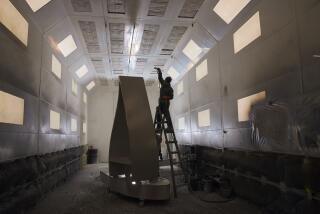CES 2013: Lighting up the smart home
Smartphones. Smart TVs. Smart appliances. Smart ... light bulbs?
As my colleague Andrea Chang reported in Tuesday’s Times, microprocessors and connectivity have been migrating into a growing number of product categories. That trend has been developing for years, but it really took off as residential broadband connections proliferated, as did home Wi-Fi networks.
For some products, the benefits of connectivity are obvious. Smart refrigerators, for example, can suggest recipes based on the food they’re chilling and create shopping lists for items that are depleted. As networking technology spreads to more mundane items, though, the appeal isn’t necessarily as apparent.
For instance, why put a communications chip in a light bulb?
That’s what GreenWave Reality of Irvine has done. The reason, said chief executive Greg Memo, is “having the light quality you want when you want it.”
GreenWave’s technology lets consumers set up networks of lights in their homes that can be precisely controlled through a smartphone or tablet app. The capabilities include turning all the lights in the network off at the touch of a (virtual) button, having different arrays of bulbs illuminated automatically at different times of day, and individually dimming each bulb in the network to vary the lighting within a room.
The bulbs use a low-power version of “personal area networking” technology -- sort of a short-distance Wi-Fi -- that requires no special sockets, switches or wiring, unlike some competing approaches to “smart” lighting. To adjust the lights wirelessly through the GreenWave app, however, owners have to plug a special gateway into their home Wi-Fi router.
CES has been awash in home-automation products for years, as companies scramble to apply digital technologies to a largely analog collection of home controls. GreenWave is a good example of the burgeoning amount of incremental, do-it-yourself upgrades that provide the building blocks for a digitally enhanced home.
Memo left networking giant Cisco in 2009 to create GreenWave, aiming to apply the benefits of connectivity to more household items. “The analogy I give,” he said, “is that everything in your life is getting smart, except your home.”
GreenWave started with energy management products, focusing on residential markets but working primarily with deregulated utilities in Europe, Australia and New Zealand. Those utilities can be more avid proponents of energy conservation than their regulated counterparts on these shores. The company announced its foray into connected lighting in October; Memo said he expects its products to be in U.S. stores in the first quarter of the year.
A package of four LED bulbs, a gateway and a remote control will sell for around $200, with each additional bulb priced around $20, Memo said. Each bulb uses about $15 worth of electricity less than a comparable incandescent light each year, he said, and they’re expected to last more than 20 years.
The company touts the bulbs as an early example of the “Internet of things,” an emerging network of chip- and sensor-equipped devices that communicate with one another to improve performance or deliver services. That’s too abstract to be a sales pitch, so Memo puts it another way: Connected lighting offers a better experience at lower cost than the conventional version.
ALSO:
CES 2013: Samsung hints at ‘unprecedented’ design
CES 2013: Pure brings connected speakers to the U.S.
CES 2013: Micro-who? CES not hurt by Microsoft’s absence this year
Healey writes editorials for The Times. Follow him on Twitter @jcahealey
More to Read
Inside the business of entertainment
The Wide Shot brings you news, analysis and insights on everything from streaming wars to production — and what it all means for the future.
You may occasionally receive promotional content from the Los Angeles Times.











